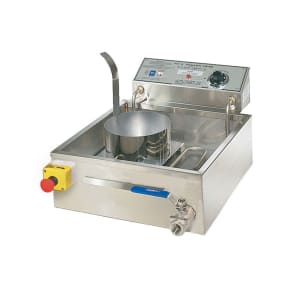Funnel Cake Fryers
Because funnel cakes and other products with heavy batters spend their cooking time in shallow cooking oil, a fryer had to be designed without an element in the vat so they wouldn't get burnt. Instead, the burners or elements in funnel cake fryers are beneath the cooking pot, and heat is conducted through the bottom to the oil. This design also prevents batter sediment having a place to get stuck and carbonize around the burners, which means better-quality food and longer-lasting oil. This design also lends itself well to cooking doughnuts, tempura, and battered fish. More

Electrically powered funnel cake fryers tend to produce less ambient heat than gas ones, keeping kitchen temperatures cooler.

For a portable fryer, choose an LP-heated model that uses a small tank of gas, while more permanent installations can use natural gas utilities.
Besides the lack of an element in the pot, what also separates funnel cake fryers from other types is the shape of the vat. The bottom of the cooking pot on these models is flat, which is why they're sometimes grouped into a larger category of flat-bottom fryers. Other types of fryers have a sediment zone, an area where loose batter collects. These models do not have that area, meaning that their frypots must be cleaned more frequently. The pot is heated from below and the funnel cakes float on or near the oil's surface. While this design is great for certain foods such as funnel cakes and doughnuts, it should not be used in high-volume operations or for dense foods such as french fries or chicken.
Cake Capacity
The first item you need to think about when purchasing a funnel cake fryer is how many cakes you want to fry at one time. Described here as cake capacity, this is determined by the width and depth of the model, as well as the power of the burners. Typical models have a capacity between three and eight cakes. If your concession stand sells only a few cakes a day, a smaller model would be the best choice. On the other hand, if you serve the treats in high-volume, at fairs or festivals, for example, you may want the largest model available.
Configurations
You can purchase models heated by electric or gas. This decision should partially be based on what utility hook-ups are available to your operation or which of them is cheaper, if you have both. If you'll be using one in a permanent location, you might have access to both. Mobile operators may be more challenged to find appropriate electric supply at every location, so a model that can be run on bottled propane might be their safest choice.
Gas
Gas funnel cake fryers take less time to reach the desired temperature and can warm to a higher temperature than electric models. If you decide to go with a gas model, note that there are models designed for propane (LP) and natural gas (NG). Make sure that you purchase the right kind for the utilities offered at your establishment.
A range of BTU outputs from 45,000 to 95,000 are available. Models with a higher BTU rating can typically cook cakes faster by keeping temperatures at set levels as cold items are introduced to the oil, but they will require more from your utilities. Some models are designed for outdoor use. These models can hook up to a portable gas tank, enabling you to move them from venue-to-venue.
Electric
An electric funnel cake fryer is a popular choice for smaller venues. Because it does not require a gas connection, it can be unplugged and moved to new locations. Typically, the main reason establishments chose electric over gas is because of lower initial and installation costs. Electric models are available in voltages of 115, 208, 230, and 240. Whichever you purchase, make sure your facilities can accommodate its plug type.
Type
Models can be either placed on a countertop or stand on the floor. Countertop models are the most popular. Typically less expensive, these can be easily placed on most countertops and work tables. Floor models are larger units that must sit on the floor.

